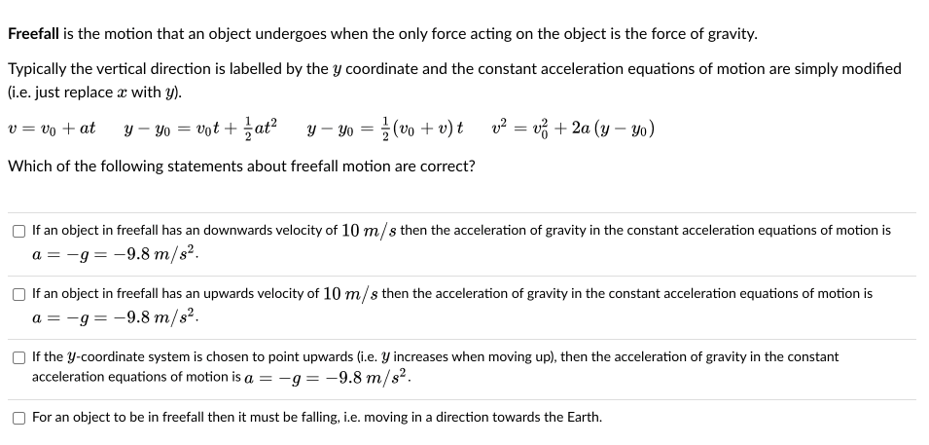Freefall is the motion that an object undergoes when the only force acting on the object is the force of gravity. Typically the vertical direction is labelled by the y coordinate and the constant acceleration equations of motion are simply modified (i.e. just replace æ with y). v = vo + at__y– yo = vot + ¿at² y– Yo = }(vo + v) t v² = vỷ + 2a (y – yo) Which of the following statements about freefall motion are correct?
Freefall is the motion that an object undergoes when the only force acting on the object is the force of gravity. Typically the vertical direction is labelled by the y coordinate and the constant acceleration equations of motion are simply modified (i.e. just replace æ with y). v = vo + at__y– yo = vot + ¿at² y– Yo = }(vo + v) t v² = vỷ + 2a (y – yo) Which of the following statements about freefall motion are correct?
Physics for Scientists and Engineers
10th Edition
ISBN:9781337553278
Author:Raymond A. Serway, John W. Jewett
Publisher:Raymond A. Serway, John W. Jewett
Chapter3: Vectors
Section: Chapter Questions
Problem 7P: A force F1 of magnitude 6.00 units acts on an object at the origin in a direction = 30.0 above the...
Related questions
Question

Transcribed Image Text:Freefall is the motion that an object undergoes when the only force acting on the object is the force of gravity.
Typically the vertical direction is labelled by the y coordinate and the constant acceleration equations of motion are simply modified
(i.e. just replace a with y).
v = vo + at
y – Yo = vot + ať?
y – Yo = } (vo + v) t v? = v3 + 2a (y – yo)
Which of the following statements about freefall motion are correct?
If an object in freefall has an downwards velocity of 10 m/s then the acceleration of gravity in the constant acceleration equations of motion is
a = -g = -9.8 m/s².
If an object in freefall has an upwards velocity of 10 m/s then the acceleration of gravity in the constant acceleration equations of motion is
a = -g = -9.8 m/s².
If the Y-coordinate system is chosen to point upwards (i.e. Y increases when moving up), then the acceleration of gravity in the constant
acceleration equations of motion is a = -g= -9.8 m/s².
For an object to be in freefall then it must be falling, i.e. moving in a direction towards the Earth.
Expert Solution
This question has been solved!
Explore an expertly crafted, step-by-step solution for a thorough understanding of key concepts.
Step by step
Solved in 2 steps

Knowledge Booster
Learn more about
Need a deep-dive on the concept behind this application? Look no further. Learn more about this topic, physics and related others by exploring similar questions and additional content below.Recommended textbooks for you

Physics for Scientists and Engineers
Physics
ISBN:
9781337553278
Author:
Raymond A. Serway, John W. Jewett
Publisher:
Cengage Learning

Physics for Scientists and Engineers with Modern …
Physics
ISBN:
9781337553292
Author:
Raymond A. Serway, John W. Jewett
Publisher:
Cengage Learning

Physics for Scientists and Engineers
Physics
ISBN:
9781337553278
Author:
Raymond A. Serway, John W. Jewett
Publisher:
Cengage Learning

Physics for Scientists and Engineers with Modern …
Physics
ISBN:
9781337553292
Author:
Raymond A. Serway, John W. Jewett
Publisher:
Cengage Learning